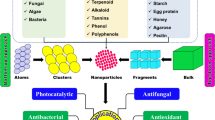Abstract
Superfine cerium-zinc oxides Ce1−x Zn x O2−x with x = 0, 0.1, 0.3, 0.5, and 1.0 were obtained by grinding Ce(SO4)2·2O, ZnSO4·7H2O and NH4HCO3 under the condition of surfactant PEG-400 being present at room temperature, washing the mixture with water to remove soluble inorganic salts, drying at 80°C, and calcining. The precursor and its calcined samples were characterized using thermogravimetry and differential thermal analyses (TG/DTA), UV-vis absorption spectroscopy, X-ray powder diffraction (XRD), and scanning electron microscopy (SEM). The results showed that superfine Ce1−x Zn x O2−x behaved as an excellent UV-shielding material. The ZnO-doped CeO2 can facilitate the formation of crystalline state CeO2. The catalytic ability of products used in air oxidation of castor oil was investigated. The results showed that the catalytic abilities of products decreased with increasing zinc amount.
Similar content being viewed by others
References
Asano S., Science of sunscreens, Hyoumenkagaku, 1994, 15: 473.
Masaki H., Skin damage induced by solarlight exposure and problems of sunscreen in the 21st century, Fragrance J., 1998, 26: 65.
Neades R., Cox L., and Pelling J.C., S-phase arrest in mouse keratinocytes exposed to multiple doses of ultraviolet B/A radiation, Mol. Carcinog., 1998, 23: 159.
He Q., Yin S., and Sato T., Synthesis and photochemical properties of zinc-aluminum layered double hydroxide/organic UV ray absorbing molecule/silica nanocomposites, J. Phys. Chem. Solids, 2004, 65: 395.
Dransfield G.P., Inorganic sunscreens, Radiat. Prot. Dosim., 2000, 91: 271.
Yabe S. and Sato T., Cerium oxide for sunscreen cosmetics, J. Solid State Chem., 2003, 171: 7.
El-Toni A.M., Shu Yin S., and Sato T., Synthesis and silica coating of calcia-doped ceria/plate-like titanate (K0.8Li0.27Ti1.73O4) nanocomposite by seeded polymerization technique, Mater. Chem. Phys., 2007, 103: 345.
Masui T., Hirai H., Imanaka N., and Adachi G., New sunscreen materials based on amorphous cerium and titanium phosphate, J. Alloys Compd., 2006, 408–412: 1141.
Wu W.W., Fan Y.J., Wu X.H, Liao S., Huang X.F, and Li X.H., Preparation of nano-sized cerium and titanium pyrophosphates via solid-state reaction at room temperature and study on their UV absorbency, Rare Met., 2009, 28: 33.
Fujishima A. and Honda K., Electrochemical photolysis of water at a semiconductor electrode, Nature, 1972, 238: 37.
Herrmann J.M., Guillard C., and Pichat P., Heterogeneous photocatalysis: an emerging technology for water treatment, Catal. Today, 1993, 17: 7.
Trovarelli A. Catalysis by Ceria and Related Materials, Imperial College Press, London, 2002.
Ahmed M.E.T., Shu Y., Shinryo Y., Tsugio S., Coating of calcia-doped ceria with amorphous silica shell by seeded polymerization technique, Mater. Res. Bull., 2005, 40: 1059.
Li R., Yabe S., Yamashita M., Momose S., Yoshida S., Yin S., and Sato T., UV-shielding properties of zinc oxide-doped ceria fine powders derived via soft solution chemical routes, Mater. Chem. Phys., 2002, 75: 39.
El-Toni A.M., Yin S., and Sato T., Synthesis and silica coating of calcia-doped ceria/mica nanocomposite by seeded polymerization technique, Appl. Surf. Sci., 2006, 252: 5063.
Xin X.Q. and Zheng L.M., Solid state reactions of coordination compounds at low heating temperatures, J. Solid State Chem., 1993, 106: 451.
Yabe S., Yamashita M., Momose S., Tahira K., Yoshida S., Li R., Yin S., and Sato T., Synthesis and UV-shielding properties of metal oxide doped ceria via soft solution chemical processes, Int. J. Inorg. Mater., 2001, 3: 1003.
Wu W.W. and Jiang Q.Y., Preparation of nano-crystalline zinc carbonate and zinc oxide via solid state reaction at room temperature, Mater. Lett., 2006, 60: 2791.
Author information
Authors and Affiliations
Corresponding author
Rights and permissions
About this article
Cite this article
Wu, W., Li, S., Liao, S. et al. Preparation of new sunscreen materials Ce1−x Zn x O2−x via solid-state reaction at room temperature and study on their properties. Rare Metals 29, 149–153 (2010). https://doi.org/10.1007/s12598-010-0026-2
Received:
Revised:
Accepted:
Published:
Issue Date:
DOI: https://doi.org/10.1007/s12598-010-0026-2




